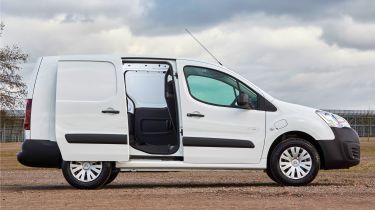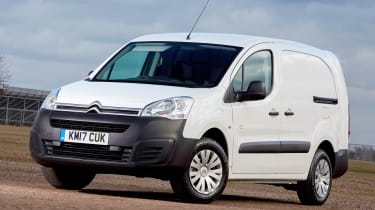Citroen Berlingo Electric (2013-2019) van review
The Citroen Berlingo Electric van used tried-and-tested running gear, but it has a short range compared to better-developed rivals

Pros
- Three-seater
- Tried-and-tested van technology
- Can add a full charge overnight
Cons
- Short range
- Dated driving experience
- Expensive for what you get
| Van type | Electric range | Walbox charge time | Rapid charge time |
|---|---|---|---|
| Electric | 106 miles (NEDC) | 8hrs (0-100%) | 30mins (10-80%) |
Even in electric-vehicle terms, the Citroen Berlingo Electric is something of a niche choice. It was on sale from 2013 to 2019, during which time it was a rival to the Renault Kangoo Z.E. and Nissan e-NV200, but annual sales never rose past double figures in the UK. Like the regular Berlingo van it's based on, it has a Peugeot sister model in the form of the Peugeot Partner Electric.
Both the Partner and Berlingo have now been discontinued, but second-generation models are on the horizon, based on the new internal-combustion-engined Partner and Berlingo that's already on sale.
The Berlingo Electric wasn't the first electric van built by Citroen. It was preceded by the Berlingo Electrique, which was originally made for use by the French postal service. Customer versions were also offered, and that model in turn followed an electric version of the old Citroen C15. But while Citroen has dabbled in electric vans over the years, it hasn't really embraced the technology as wholeheartedly as rival Renault.
This latest Berlingo Electric was far better than its predecessors, but with a 49kW electric motor producing 66bhp and twin battery packs making a combined output of 22.5kWh, it has an estimated driving range of only 106 miles – some 70 miles short of the claimed range for the Kangoo. That figure was also achieved on the discontinued NEDC test, which is misleadingly optimistic, so you can expect a real-world range of more like 60 miles.
Citroen offered two charging options. The fastest is a CHAdeMO high-voltage socket on the nearside rear of the van, which can charge the batteries to 80% from flat in 30 minutes from a high-voltage source. Charging from a mains socket takes a more leisurely 12 hours from a socket on the offside front wing, but that means a flat battery can be recharged overnight.
There was only ever a single version of the Berlingo Electric sold, based on the LX trim of the diesel model and available in L1 or L2 body lengths. The difference between the two is increased load volume for the L2 (3.7 cubic metres, compared to 3.3 for the L1) and different payload weights (636kg for the L1 and 552 for the L2, including driver).
The L2 also comes with twin sliding side doors, compared to just a nearside door for the L1. There was no option to add a second side door to the L1 model, while both vans have offset double rear doors as standard and no top-hinged tailgate.
There's a charge monitor in the instrument pod where the rev counter of the diesel version normally sits, while air-conditioning was fitted as standard, but there's no pre-heating function available. The hard plastics, upright dashboard, orange dot-matrix displays and painted metal surfaces leave you in no doubt about this van's functional nature.
One positive the Berlingo did offer over a Kangoo Z.E. was an optional steel bulkhead with glazed window, which helps reduce interior noise, but still lets you keep an eye on your payload. A three-abreast seat layout adds a touch of versatility, too, even if the seats themselves are a bit narrow.

On the road, the Berlingo Electric sprints away from the line briskly enough, although the relative lack of power means it soon runs out of steam. The van is based on running gear that can trace its roots back to 2001, so it's not very nimble, especially due to the weight of the batteries, which add around 300kg to the weight of the standard model.
For a more detailed look at the Citroen Berlingo Electric, read on for the rest of our in-depth review.




